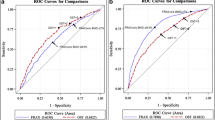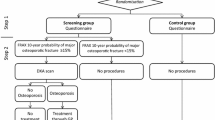Abstract:
Bone mineral density (BMD) measurement is widely recognized as the best single tool to identify patients with a high lifetime risk of developing an osteoporosis-related fracture. However, the cost/benefit value of screening the whole population has been repeatedly challenged and demonstrated to be rather poor. In many countries, BMD scan is not or no longer reimbursed because of lack of validated criteria to identify patients who should benefit from this procedure. Based on the proposals of a nationwide expert panel, a simple questionnaire identifying historical, clinical and behavioral risk factors for osteoporosis was developed. The aim of this study was to assess the diagnostic accuracy of the proposed criteria; to determine the extent to which this questionnaire could be useful for optimizing the use of densitometry tests; and, more specifically, to estimate the diagnostic costs per osteoporotic or osteopenic patient detected. For this purpose, we applied the questionnaire to 3998 consecutive individuals at least 20 years old, of both genders, either consulting spontaneously or referred for a BMD measurement to an outpatient osteoporosis center. BMD was measured by dual-energy X-ray absorptiometry (DXA) at the lumbar spine and at the hip (both total hip and femoral neck). Diagnostic accuracies were evaluated through measures of sensitivity, specificity, and positive and negative predictive values. After determining a benchmark value for age, different strategies were compared in order to identify the most cost-effective one in terms of cost per patient detected. According to the WHO operational definition of osteoporosis (T-score <–2.5), 31% of the subjects were classified as osteoporotic at one or more of the measured sites. If only patients with at least one of the proposed risk factors had been referred for scans, 33.3% of the BMD measurements would have been avoided. Among those, less than 5% were missclassified as they did have osteoporosis at the total hip and up to 23% at one or more of the considered sites. On the other hand, of the subjects who would be recommended for a densitometry test, only a small fraction were identified correctly (the positive predictive values varied from 11.3% at the total hip to 34.8% at any site). In this first setting, the suggested criteria seem useful chiefly for excluding subjects who do not need a DXA scan rather than selecting osteoporotic patients. When applied only to patients aged 61 years or more, the positive predictive values rose to 15.1% (total hip) and 42.9% (any site), whereas the corresponding negative predictive values were set at 93% and 68.6%. In comparison, with a mass screening scenario the estimated diagnostic costs (costs associated with the DXA procedure) per osteoporotic patient detected at any of the considered sites would be reduced by more than 9% (59.4 instead of 65.3 Euros) if the suggested indications are taken into account for prescreening patients. And when the questionnaire is applied only to women over the age of 60 years these costs would be further reduced to 50.6 Euros, representing a 23% decrease. Then, a prescreening strategy based on these indications concomitantly with an age-selective criterion could represent a promising way toward a more rational use of BMD measurement.
Similar content being viewed by others
Author information
Authors and Affiliations
Additional information
Received: 12 April 2001 / Accepted: 29 November 2001
Rights and permissions
About this article
Cite this article
Ben Sedrine, W., Broers, P., Devogelaer, JP. et al. Interest of a Prescreening Questionnaire to Reduce the Cost of Bone Densitometry . Osteoporos Int 13, 434–442 (2002). https://doi.org/10.1007/s001980200051
Issue Date:
DOI: https://doi.org/10.1007/s001980200051




